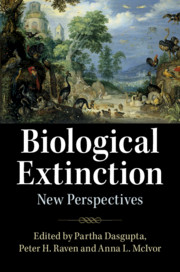Book contents
- Biological Extinction: New Perspectives
- Biological Extinction: New Perspectives
- Copyright page
- Dedication
- Contents
- Figures
- Tables
- Contributors
- Preface
- Acknowledgements
- Introduction
- Prologue
- 1 Extinction in Deep Time
- 2 Biodiversity and Global Change
- 3 The State of the World’s Biodiversity
- 4 Extinction Threats to Life in the Ocean and Opportunities for Their Amelioration
- 5 Out of the Soil
- 6 The Green Revolution and Crop Biodiversity
- 7 Population
- 8 Game Over?
- 9 Why We’re in the Sixth Great Extinction and What It Means to Humanity
- 10 The Consequences of Biodiversity Loss for Human Well-Being
- 11 Terra Incognita
- 12 How Do We Stem Biodiversity Loss?
- 13 Can Smart Villages Help to Stem Biodiversity Loss?
- 14 The New Design Condition
- Index
- Plate Section (PDF Only)
- References
Introduction
Published online by Cambridge University Press: 19 August 2019
- Biological Extinction: New Perspectives
- Biological Extinction: New Perspectives
- Copyright page
- Dedication
- Contents
- Figures
- Tables
- Contributors
- Preface
- Acknowledgements
- Introduction
- Prologue
- 1 Extinction in Deep Time
- 2 Biodiversity and Global Change
- 3 The State of the World’s Biodiversity
- 4 Extinction Threats to Life in the Ocean and Opportunities for Their Amelioration
- 5 Out of the Soil
- 6 The Green Revolution and Crop Biodiversity
- 7 Population
- 8 Game Over?
- 9 Why We’re in the Sixth Great Extinction and What It Means to Humanity
- 10 The Consequences of Biodiversity Loss for Human Well-Being
- 11 Terra Incognita
- 12 How Do We Stem Biodiversity Loss?
- 13 Can Smart Villages Help to Stem Biodiversity Loss?
- 14 The New Design Condition
- Index
- Plate Section (PDF Only)
- References
Summary
Humanity’s future will be shaped by the portfolio of capital assets we inherit and choose to pass on to our descendants, and by the balance we strike between the portfolio and the size of our population. So it makes sense to include population on the list of a society’s assets and build an overarching study of our relationship with our descendants and with nature by dividing assets into three categories: produced capital (buildings, roads, ports, machines, instruments), human capital (population, health, education, knowledge and skills) and natural capital (biodiversity, ecosystems, subsoil resources). In this Introduction we offer a perspective on the chapters that follow by summarising salient aspects of humanity’s troubled relationship with the biosphere.
- Type
- Chapter
- Information
- Biological ExtinctionNew Perspectives, pp. 1 - 14Publisher: Cambridge University PressPrint publication year: 2019



